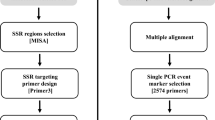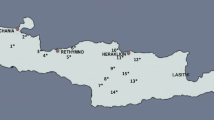Abstract
Solidity of microsatellite markers is a key issue for varietal identification, especially when they are used for legal purposes, what includes their probable future use in the distinctness, uniformity and stability testing of new varieties needed for the granting of Plant Breeders’ Rights. Nine grapevine microsatellites (VVS2, VVMD5, VVMD27, VVMD28, ssrVrZAG29, ssrVrZAG62, ssrVrZAG67, ssrVrZAG83 and ssrVrZAG112), which had previously demonstrated its capacity to discriminate any grapevine variety, have been assessed to evaluate its uniformity and stability. 19 varieties were selected, representative of a high diversity for morphological, agronomical, cultural and historical aspects, as well as for microsatellite allele variability. Then, for each variety, uniformity and stability were evaluated through the analysis of 50 plants from each of three different plots, and five plants from each of seven additional plots. Material from 4,137 plants of 229 plots of the 19 varieties was sampled in seven countries. Of 3,654 plants analyzed with the set of nine microsatellites, 3,299 were of the right variety and used for the survey. An average of 172 individual values was studied for each allele of each microsatellite of each variety, and none differences were detected that could not be explained as technical variations, with the exception of several putative chimeras in two varieties. Of the total of 171 variety x microsatellite combinations, only in one combination (‘Merlot’ x VVMD27) the number of off-types exceeded the threshold allowed. The remaining 170 combinations have been found uniform and stable according to internationally accepted rules.

Similar content being viewed by others
References
Baneh HD, Mohammadi SA, Mahmoudzadeh H, de Mattia F, Labra M (2009) Analysis of SSR and AFLP markers to detect genetic diversity among selected clones of grapevine (Vitis vinifera L.) cv. Keshmeshi. S Afr J Enol Vitic 30(1):38–42
Bertsch C, Kieffer F, Maillot P, Farine S, Butterlin G, Merdinoglu D, Walter B (2005) Genetic chimerism of Vitis vinifera cv. Chardonnay 96 is maintained through organogenesis but not somatic embryogenesis. BMC Plant Biol 5(20). doi:10.1186/1471-2229-5-20
Bowers JE, Dangl GS, Vignani R, Meredith CP (1996) Isolation and characterization of new polymorphic simple sequence repeat loci in grape (Vitis vinifera L.). Genome 39:628–633
Bowers JE, Dangl GS, Meredith CP (1999) Development and characterization of additional microsatellite DNA markers for grape. Am J Enol Vitic 50(3):243–246
Chomé P, Sotés V, Benayas F, Cayuela M, Hernández M, Cabello F, Ortiz J, Rodríguez-Torres I, Chaves J (2003) Variedades de vid. Registro de variedades comerciales. Centro de Publicaciones, Ministerio de Agricultura, Pesca y Alimentación, Madrid
Cooke RJ, Bredemeijer GMM, Ganal MW, Peeters R, Isaac P, Rendell S, Jackson J, Roder MS, Korzun V, Wendehake K, Areshchenkova T, Dijcks M, Laborie D, Bertrand L, Vosman B (2003) Assessment of the uniformity of wheat and tomato varieties at DNA microsatellite loci. Euphytica 132(3):331–341
Crespan M (2004) Evidence on the evolution of polymorphism of microsatellite markers in varieties of Vitis vinifera L. Theor Appl Genet 108(2):231–237
Cretazzo E, Meneghetti S, De Andres MT, Gaforio L, Frare E, Cifre J (2010) Clone differentiation and varietal identification by means of SSR, AFLP, SAMPL and M-AFLP in order to assess the clonal selection of grapevine: the case study of Manto Negro, Callet and Moll, autochthonous cultivars of Majorca. Ann Appl Biol 157(2):213–227. doi:10.1111/j.1744-7348.2010.00420.x
Dalbó MA, Ye GN, Weeden NF, Steinkellner H, Sefc KM, Reisch BI (2000) A gene controlling sex in grapevines placed on a molecular marker-based genetic map. Genome 43:333–340
Franks TR, Botta R, Thomas MR, Franks J (2002) Chimerism in grapevines: implications for cultivar identity, ancestry and genetic improvement. Theor Appl Genet 104(2–3):192–199
Galet P (2000) Dictionnaire Encyclopédique des Cépages. Hachette, Paris
Gonzalez Techera A, Jubany S, de Ponce Leon I, Boido E, Dellacassa E, Carrau FM, Hinrichsen P, Gaggero C (2004) Molecular diversity within clones of cv. Tannat (Vitis vinifera). Vitis 43(4):179–185
Hidalgo L (1999) Tratado de Viticultura General, 2nd edn. Mundi-Prensa, Madrid
Hocquigny S, Pelsy F, Dumas V, Kindt S, Heloir MC, Merdinoglu D (2004) Diversification within grapevine cultivars goes through chimeric states. Genome 47(3):579–589
Ibáñez J, de Andrés MT, Borrego J (2000) Allelic variation observed at one microsatellite locus between the two synonym grape cultivars Black Currant and Mavri Corinthiaki. Vitis 39(4):173–174
Ibáñez J, Vargas AM, Palancar M, Borrego J, de Andrés MT (2009a) Genetic relationships among table-grape varieties. Am J Enol Vitic 60(1):35–42
Ibáñez J, Vélez M, de Andrés MT, Borrego J (2009b) Molecular markers for establishing distinctness in vegetatively propagated crops: a case study in grapevine. Theor Appl Genet 119(7):1213–1222. doi:10.1007/s00122-009-1122-2
Imazio S, Labra M, Grassi F, Winfield M, Bardini M, Scienza A (2002) Molecular tools for clone identification: the case of the grapevine cultivar ‘Traminer’. Plant Breed 121(6):531–535
Kalia R, Rai M, Kalia S, Singh R, Dhawan A (2011) Microsatellite markers: an overview of the recent progress in plants. Euphytica 177(3):309–334. doi:10.1007/s10681-010-0286-9
Moncada X, Pelsy F, Merdinoglu D, Hinrichsen P (2006) Genetic diversity and geographical dispersal in grapevine clones revealed by microsatellite markers. Genome 49(11):1459–1472
OIV (2007) 2nd edition of the OIV descriptor list for grape varieties and Vitis species. Bull OIV 60(671–672):44–82
Pelsy F (2010) Molecular and cellular mechanisms of diversity within grapevine varieties. Heredity 104(4):331–340. doi:10.1038/hdy.2009.161
Pelsy F, Hocquigny S, Moncada X, Barbeau G, Forget D, Hinrichsen P, Merdinoglu D (2010) An extensive study of the genetic diversity within seven French wine grape variety collections. Theor Appl Genet 120(6):1219–1231
Regner F, Stadlbauer A, Eisenheld C, Kaserer H (2000a) Genetic relationships among Pinots and related cultivars. Am J Enol Vitic 51(1):7–14
Regner F, Wiedeck E, Stadlbauer A (2000b) Differentiation and identification of White Riesling clones by genetic markers. Vitis 39(3):103–107
Regner F, Hack R, Santiago JL (2006) Highly variable Vitis microsatellite loci for the identification of Pinot Noir clones. Vitis 45(2):85–91
Riaz S, Garrison KE, Dangl GS, Boursiquot JM, Meredith CP (2002) Genetic divergence and chimerism within ancient asexually propagated winegrape cultivars. J Am Soc Hort Sci 127(4):508–514
Riaz S, Dangl GS, Edwards KJ, Meredith CP (2004) A microsatellite marker based framework linkage map of Vitis vinifera L. Theor Appl Genet 108(5):864–872. doi:10.1007/s00122-003-1488-5
Sefc KM, Regner F, Turetschek E, Glössl J, Steinkellner H (1999) Identification of microsatellite sequences in Vitis riparia and their applicability for genotyping of different Vitis species. Genome 42:367–373
Sefc KM, Pejic I, Maletic E, Thomas MR, Lefort F (2009) Microsatellite markers for grapevine: tools for cultivar identification & pedigree reconstruction. In: Roubelakis-Angelakis KA (ed) Grapevine molecular physiology & biotechnology, 2nd edn. Springer, New York, pp 565–596. doi:10.1007/978-90-481-2305-6_21
Tautz D (1989) Hypervariability of simple sequences as a general source for polymorphic DNA markers. Nucleic Acids Res 17(16):6463–6471
This P, Lacombe T, Thomas MR (2006) Historical origins and genetic diversity of wine grapes. Trends Genet 22(9):511–519. doi:10.1016/j.tig.2006.07.008
Thomas MR, Scott NS (1993) Microsatellite repeats in grapevine reveal DNA polymorphisms when analysed as sequence-tagged sites (STSs). Theor Appl Genet 86:985–990
Thompson MM, Olmo HP (1963) Cytohistological studies of cytochimeric and tetraploid grapes. Am J Bot 50:901–906
UPOV (2002) General introduction to the examination of distinctness, uniformity and stability and the development of harmonized descriptions of new varieties of plants. International Union for the Protection of New Varieties of Plants, Geneva
UPOV (2005) UPOV report on the impact of plant variety protection. International Union for the Protection of New Varieties of Plants, Geneva
UPOV (2008a) Examining uniformity. International Union for the Protection of New Varieties of Plants, Geneva
UPOV (2008b) Grapevine: guidelines for the conduct of tests for distinctness, uniformity and stability. International Union for the Protection of New Varieties of Plants, Geneva
UPOV (2009) Plant variety protection statistics for the period 2004–2008. International Union for the Protection of New Varieties of Plants, Geneva
Vargas AM, Velez MD, de Andres MT, Laucou V, Lacombe T, Boursiquot JM, Borrego J, Ibáñez J (2007) Corinto bianco: a seedless mutant of Pedro Ximenes. Am J Enol Vitic 58(4):540–543
Zulini L, Fabro E, Peterlunger E (2005) Characterisation of the grapevine cultivar picolit by means of morphological descriptors and molecular markers. Vitis 44(1):35–38
Acknowledgments
This study was financially supported by the project VIN01-025 (Instituto Nacional de Investigación y Tecnología Agraria y Alimentaria, Agriculture Ministry of Spain). M.D. Vélez was funded by a pre-doctoral fellowship from the Instituto Madrileño de Investigación y Desarrollo Rural, Agrario y Alimentario (IMIDRA). The large sampling needed in this work has been possible thanks to the collaboration of numerous people and public and private institutions, in Spain and abroad. We are grateful to all of them. Specifically, plant material from wine varieties was obtained thanks to the collaboration of numerous Regulator Councils of wine Origin Denominations (see Materials and methods). Among the people who personally contributed to the sampling are: José María Hurtado (Superior Frutícola S.A., Murcia, Spain); Edit Hajdu (FVM Szölészeti és Borászati Kutató Intézete, Hungary); Patricio Hinrichsen (Centro Experimental La Platina-INIA, Chile); Tim Sheehan (Sheehan Genetics, USA); Jean Satterwhite (National Clonal Germplasm Repository for Nut Crops, USA); Erika Maul (Institute for Grapevine Breeding, Germany); Jorge Zerolo (Agrovolcán, Tenerife, Spain); Nuria Cid (Estación de Viticultura y Enología de Galicia, Orense, Spain); Peter Allderman (Top Fruit, RSA); Thierry Lacombe (DGPC-Diversité et Génomes des Plantes Cultivées, France); Miguel Lara (CIFA-Centro de Investigación y Formación Agraria, Jerez de la Frontera, Spain); Joaquín Borrego, Paz Fernández, Maite de Andrés, Carlos González, Alba Vargas, Gregorio Muñoz, Cristina Rubio and Mariano Cabellos (IMIDRA, Spain). We apologize for any non-deliberate omission in this list.
Author information
Authors and Affiliations
Corresponding author
Electronic supplementary material
Below is the link to the electronic supplementary material.
Rights and permissions
About this article
Cite this article
Vélez, M.D., Ibáñez, J. Assessment of the uniformity and stability of grapevine cultivars using a set of microsatellite markers. Euphytica 186, 419–432 (2012). https://doi.org/10.1007/s10681-012-0633-0
Received:
Accepted:
Published:
Issue Date:
DOI: https://doi.org/10.1007/s10681-012-0633-0




